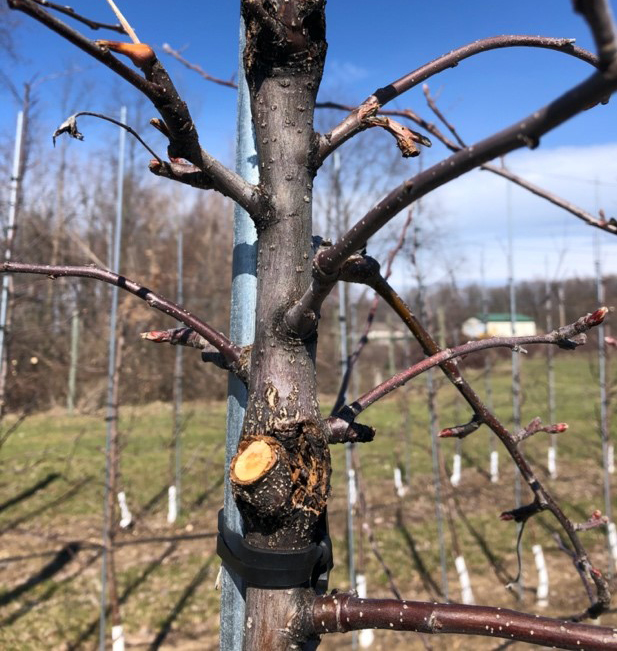Northwest Michigan fruit update – April 21, 2020
Crop development has been slow, cold weather will persist, and no bud damage has been detected at this time.

Weather report
The weather continues to be cool and as of this morning, April 21, almost winter-like. We did have a few days that felt a little spring-like, but all days have been exceptionally windy. A cold front moved in last evening and will remain here until Thursday; we had high winds last night that ushered in rain that turned into snow overnight. These conditions will likely slow some activities in the orchard.
We seem to be quite behind in accumulating growing degree days (GDD) so far this season. We have accumulated 70 GDD base 42 and 12 GDD base 50. Our 25-plus year averages at the Northwest Michigan Horticulture Research Center are 135.7 GDD base 42 and 53 GDD base 50. Soils are warming slightly, but surprisingly dry until this past wetting event.
According to Michigan State University climatologist Jeff Andresen and the future weather predictions, this cool weather will continue until May. We could be as much as 14 days behind normal, and the forecast is also predicting drier than normal conditions for this time of year. Growers should expect these cold temperatures to continue for at least the next week and a half. Andresen’s weekly report can be seen at MSU Extension’s Fruit Weather Reports page.
|
Growing degree days (GDDs) through April 21, 2020 | |||||||
|---|---|---|---|---|---|---|---|
|
Year |
2020 |
2019 |
2018 |
2017 |
2016 |
2015 |
30 Yr. Avg. |
|
GDD42 |
70 |
57 |
21 |
167 |
163 |
135 |
135.7 |
|
GDD50 |
12 |
15 |
1 |
60 |
71 |
49 |
53.8 |
Crop report
The weather may be keeping orchard activities to a minimum, but growers in Leelanau County are still pulling trees. Tree orders are also starting to come in and growers are likely eager to put trees in the ground. Both apple and cherry trees are going in this spring. Tree development is slow as a result of the cool weather. We are only starting to see some green in cherry varieties and most sweet cherries are at side green.
Both Montmorency and Balaton are at early side green and most apples are at silver tip with some very early first green starting to show. On Thursday afternoon, April 16, MSU Extension educator Nikki Rothwell collected sweet (variety unknown) and tart cherry buds from trees on Setterbo Road in Leelanau County following the two cold nights last week; buds were cut over the weekend and there was zero damage.
Pest report
With this week’s monitoring, we have found more San Jose scale and European red mites in the station apples. Red mite eggs are small, bright red spheres on roughened bark areas on the tree such as at the base of branches, buds and spurs (Photo 1). We have received reports that San Jose scale are not difficult to find in commercial sweet cherry and apple blocks where this pest was present last year. Unfortunately, cold temperatures have not been favorable for dormant applications for these pests so far this season. If weather warms, we could have a window; however, growers should be prepared that other in-season measures may be needed to keep scale and red mites in check this season.
Fire blight was a challenge for some growers last season, including at the research station. Photo 2 shows a Gala tree with multiple cankers in the main trunk. Trees with this level of damage have been and should be removed from the block completely, but we left this one to monitor for when the cankers begin to ooze this season.

On warmer days, brown marmorated stink bugs are waking up from overwintering structures (e.g., Emily Pochubay’s house), and we have received reports from other agriculture consultants that this pest has recently become active in their homes as well. In terms of crop damage, this pest is not a concern at this time. However, if you do find a brown marmorated stink bug in your house, shed or barn, be sure to make a mental note as we will be on the lookout for these later in the season.
As noted in the crop report, cold weather has continued to delay crop, pest and disease development. We will set traps for early season pests like spotted tentiform leafminer and oriental fruit moth next week, but this timing is about a week later than normal for our trapline.



 Print
Print Email
Email



